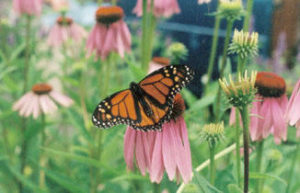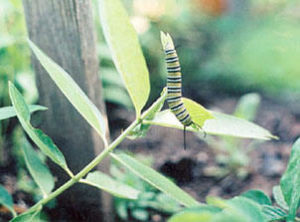 |
| Monarch butterfly adults feed on Echinacea (and many other species), while larvae require milkweed leaves. Planting for Monarchs can help these animals as they face habitat destruction and limited food sources in industrial-agricultural monocultures. Photo by Larry Lack. |
 |
| Monarch caterpillar feeding on milkweed leaves. Photo by Larry Lack. |
By Larry Lack and Lee Ann Ward
Shortly after moving to St. Andrews, New Brunswick, five years ago, while visiting friends in Carleton County, we learned that the exquisitely beautiful Monarch butterfly, threatened in much of its North American range by over-development, chemical agriculture and habitat destruction, was also struggling in New Brunswick, where milkweed, its favorite and necessary food, has been eliminated from many farm fields where herbicides are used. Our friends showed us their milkweed patch and told us this attractive weed, with its striking, feathery-filmy seed pods, had enabled them to draw, feed and sustain a modest population of monarchs, whose bold black and orange wing design, splashed with white dots and highlights, more than justifies the species’ regal name.
Over the next few years our garden was visited by a various butterflies, including Painted Ladies, Tiger Swallowtails, and even a few noisy Sphinx Moths that often are mistaken for hummingbirds as they hover, buzz and extract nectar with their long proboscis. Several times in those years we thought we glimpsed Monarchs, but they were far away, and we could not be sure.
Milkweed grows in coastal Charlotte County, but it’s more common inland, where summer temperatures are higher. So we asked our friends, whose farm slopes down to the St. John River near Woodstock, to send us some milkweed seed. A fat envelope full of pods and seeds arrived, and quite late in the fall, we spread the seeds on a 3- x 4-foot plot in the garden and covered them lightly with soil. The following spring they popped up and grew enthusiastically, crowding one another so that we had to thin them several times.
Meanwhile our bed of Echinacea (purple coneflowers) had hit its stride, and by June it was producing scores of showy pink and purple, long-lasting, pollen- and nectar-laden blooms. We didn’t know that Echinacea is a favorite nectar source for Monarchs until, soon after its cone-shaped flowers started opening, we began seeing adult Monarchs perched, wings folded, feeding hungrily, sometimes for several minutes, on one coneflower after another.
About the same time we started noticing that Monarchs were beating their wings, pushing against the mesh of the deer fence around part of the garden that includes the milkweed patch. After some valiant efforts to get through the mesh, some Monarchs found the top of the fence, flew over it and headed straight to the milkweed. Several weeks later I discovered the results of their visits to these plants, which were not yet in flower, but which the Monarchs had obviously sensed and honed in on.
In mid-July I thinned the milkweed again, and when I went back a few days later to see if the plants had responded to the thinning and the subsequent rain, for the first time I saw the Monarch caterpillars.
They are as unusual and elegant as the adults they will become, about 3 ½ inches long, with a series of black, white and yellow stripes and shiny black “horns” at either end, behind each of their “heads.” (Their real heads are mimicked by false ones at their tail ends.) These striking features warn predators that the caterpillar will sicken them, with glycosides absorbed from the milkweed.
Despite the similar appearance of their paired “front and rear” heads, it wasn’t hard to tell which head was real. These fat “worms” are very active, swinging, squirming and crawling from branch to branch with prominent mouth parts moving rapidly from side to side, cutting jagged slices of the foliage as they move along the milkweed stems and leaves. Within four or five days, a dozen of these busy, clown-clad creatures had devoured almost half the milkweed foliage and left the decimated patch for parts unknown.
A few weeks later we found two Monarch chrysalises, or pupae, one attached to a broccoli stem, the other to the bottom of a leaf lying on a compost pile. These are among the most amazing insect life forms we’ve ever seen. One of our garden helpers, a young jeweler, remarked: “This thing is like a precious jewel.”
The iridescent, almost glowing, pale green pupa case is shaped like a blunt cylinder or bullet about half the size of a human thumb, with a small hook at one end. It features tiny spots of gold flashing against the green, and an amazing and delicate dotted line of gold, like stitched gold thread running halfway around the circumference of the cylinder near the top. Add to all this beauty the fact that the pupae were gently throbbing, likely close to releasing the folded butterflies inside, and this discovery nearly knocked our socks off, presenting us with an intense, almost paranormal revelation of the miraculous pulsing heart of nature, the diverse and teeming insect world that secretly coexists with ours in the grassy, leafy shadows hidden in the glare of our narrow, half-conscious human preoccupations.
Monarchs east of the Rockies migrate in huge flocks to a mountain range in central Mexico, to hibernate suspended in great bunches from certain trees. In spring, they take a second, shorter, northward flight, laying eggs en route to start the cycle over.
The lowly milkweed is the key to attracting these extraordinary animals. Try it yourself. Monarchs are among the most beautiful and inspiring visitors you will ever get the chance to host.
Plants to Attract Butterflies
In addition to Echinacea purpurea, “Rodale’s Encyclopedia of Organic Gardening” (1992) lists, among others, the following plants to attract butterflies:
Herbaceous flowers: hollyhock, milkweed, butterfly weed, aster, oxeye daisy, rudbekia (black-eyed Susans), sunflower, daylily, lavender, mints, phlox, bee balm, sage, goldenrod, French marigold, thyme, verbena and zinnia.
Woody plants: honeysuckle (don’t plant invasive species!), sumac, willow, lilac, basswood (linden) and blueberry.
To this list we’d add flowering tobacco; false spirea – a hardy shrub native to the Maritimes; and anise hyssop – a handsome herb with large, rodlike blue blooms. Anise hyssop leaves make a great licorice/mint tea, while the flowers draw butterflies and, like false spirea and tobacco, feed dozens of species of pollinators.
With plants like these and a good insect identification guide, you’ll have hours of happy backyard bug observing in store when your gardens bloom.
– LL and LAW
This article was originally published in Rural Delivery. Larry and Lee Ann live in St. Andrews, New Brunswick.
